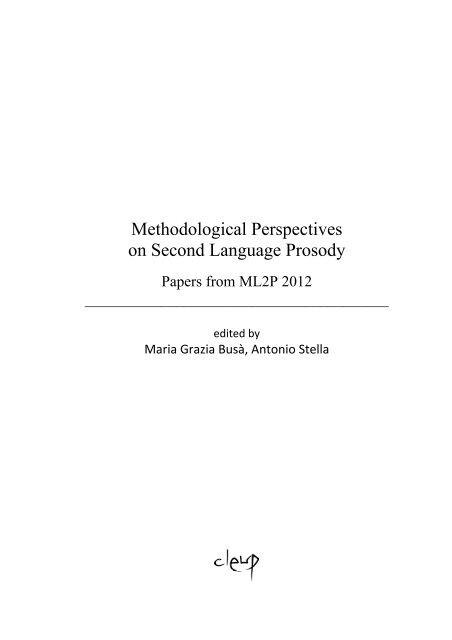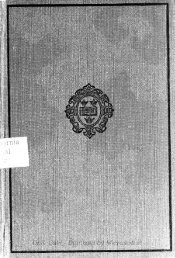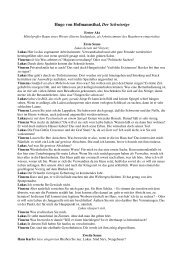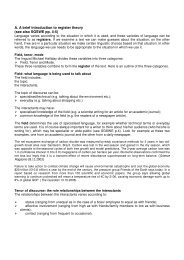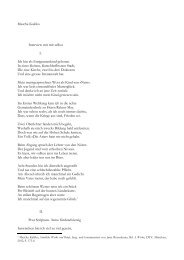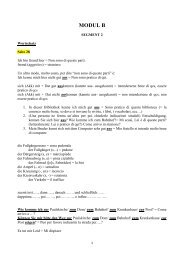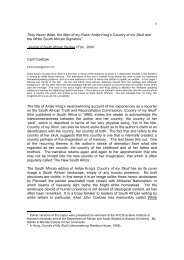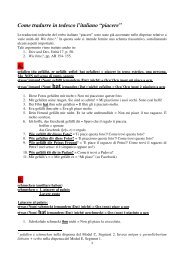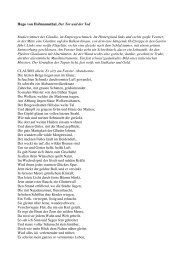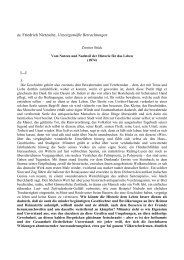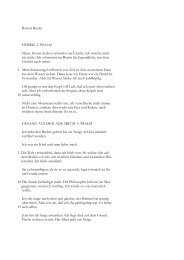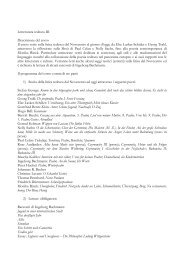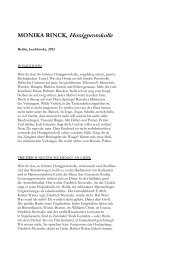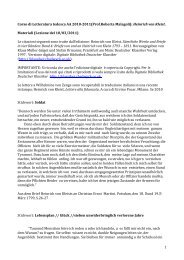Methodological Perspectives on Second Language Prosody
Methodological Perspectives on Second Language Prosody
Methodological Perspectives on Second Language Prosody
Create successful ePaper yourself
Turn your PDF publications into a flip-book with our unique Google optimized e-Paper software.
<str<strong>on</strong>g>Methodological</str<strong>on</strong>g> <str<strong>on</strong>g>Perspectives</str<strong>on</strong>g><br />
<strong>on</strong> Sec<strong>on</strong>d <strong>Language</strong> <strong>Prosody</strong><br />
Papers from ML2P 2012<br />
________________________________________<br />
edited by<br />
Maria Grazia Busà, Ant<strong>on</strong>io Stella
Prima edizi<strong>on</strong>e: novembre 2012<br />
ISBN 978 88 6129 937 5<br />
© CLEUP Sc<br />
Coop. Libraria Editrice Università di Padova<br />
Via Belz<strong>on</strong>i — 118/3 — Padova (Tel. 049/650261)<br />
www.cleup.it<br />
Tutti i diritti di traduzi<strong>on</strong>e, riproduzi<strong>on</strong>e e adattamento,<br />
totale o parziale, c<strong>on</strong> qualsiasi mezzo (comprese<br />
le copie fotostatiche e i microfilm) s<strong>on</strong>o riservati.
HOW CREDIBLE IS A NON-NATIVE SPEAKER?<br />
PROSODY AND SURROUNDINGS<br />
Anna De Meo<br />
University of Naples “L’Orientale”<br />
ademeo@unior.it<br />
ABSTRACT<br />
In order to evaluate the segmental and suprasegmental acoustic credibility correlates in the percepti<strong>on</strong> of<br />
native and n<strong>on</strong>-native speech, a study was c<strong>on</strong>ducted <strong>on</strong> native and n<strong>on</strong>-native speakers (NSs and NNS) of<br />
Italian. NNSs were chosen <strong>on</strong> the basis of L2 level of competence (A2, B1, C1 of CEFR), mother t<strong>on</strong>gues<br />
(Chinese, Arabic, Japanese and Vietnamese) and degree of foreign accent (mild vs. str<strong>on</strong>g). Four perceptive<br />
tests were carried out, two of them based <strong>on</strong> natural speech and the other two <strong>on</strong> modified speech. The<br />
corpus, formed by bizarre-but-true news read in Italian by all the involved subjects, was organized in form of<br />
radio news magazines and was used to c<strong>on</strong>duct the tests. Native Italian listeners were asked to assess the<br />
truthfulness of each news item and its comprehensibility. Results revealed that the correlati<strong>on</strong> between<br />
foreign accent and credibility is delivered by comprehensibility: poor comprehensibility generally lowers the<br />
credibility level of an utterance. When comprehensibility is high, a reduced t<strong>on</strong>al range and l<strong>on</strong>ger silent<br />
pauses, i.e. the suprasegmental features of the utterance, determine a significant increase of trustworthiness.<br />
Keywords: foreign accent, credibility, L2 Italian, prosody, comprehensibility.<br />
1. INTRODUCTION<br />
Direct pers<strong>on</strong>al experience and other people’s<br />
oral/written communicati<strong>on</strong> c<strong>on</strong>stitute a major<br />
source for gathering new informati<strong>on</strong>, although<br />
most of this c<strong>on</strong>tent is filtered out and <strong>on</strong>ly what is<br />
thought to be useful is retained. One of the primary<br />
criteria used to select the collected informati<strong>on</strong> is<br />
its credibility. Sources are defined credible or<br />
believable when they are described as trustworthy<br />
or as having experience [10, 16, 21]. If the<br />
informati<strong>on</strong> is rejected, because it is judged as not<br />
credible, it is not going to be learned nor stored in<br />
the memory and it will not have any impact <strong>on</strong><br />
<strong>on</strong>e’s life. Given that credibility has such an<br />
influence <strong>on</strong> the message, it is important to<br />
understand how people decide what to believe in.<br />
Message credibility is generally the result of<br />
interacti<strong>on</strong>s between source characteristics, e.g.<br />
expertise, trustworthiness, dynamism, authority,<br />
and message features as perceived by the recipient<br />
of the message. Factors that impact credibility are<br />
also str<strong>on</strong>gly related to receiver’s characteristics<br />
and include cultural background, previous<br />
believes, age, gender, country of origin, educati<strong>on</strong>,<br />
etc.<br />
Speaker’s accent, defined as the perceived<br />
segmental and prosodic deviati<strong>on</strong>s from “standard<br />
norms” in native and n<strong>on</strong>-native speech producti<strong>on</strong><br />
(regi<strong>on</strong>al accent vs foreign accent) [3, 11, 14, 18],<br />
may impact his/her credibility because it can<br />
activate listeners’ positive or negative prejudices or<br />
stereotypes, i.e. prec<strong>on</strong>ceived beliefs about a group<br />
of people or cultural practices [8, 17].<br />
As Italy c<strong>on</strong>fr<strong>on</strong>ts increasing diversity,<br />
primarily due to migrati<strong>on</strong> (150 languages spoken<br />
by more than 3.5 milli<strong>on</strong>s immigrants) and<br />
globalizati<strong>on</strong> trends, listener’s percepti<strong>on</strong>s of the<br />
varieties of spoken Italian has deeply modified.<br />
Prejudice, <strong>on</strong>ce regarding regi<strong>on</strong>al varieties and<br />
dialects [1, 7, 20] has shifted towards foreignaccented<br />
varieties [4]. Foreign accented speech<br />
may positively or negatively affect social<br />
behaviours. In service c<strong>on</strong>texts where visual cues<br />
are absent (call centers), customer’s percepti<strong>on</strong> of<br />
service quality may be unfavorably influenced by<br />
accent-related stereotype activati<strong>on</strong>. Listeners’<br />
prejudicial reacti<strong>on</strong>s may thus impact<br />
employements aspects [19].<br />
To this regard, according to Lev-Ari and<br />
Keysar [9], foreign accent makes n<strong>on</strong>-native<br />
speakers less truthful to listeners, not just because<br />
of prejudice towards foreigners, but rather because<br />
of the voice signal characteristics, that would cause<br />
processing difficulties. his assumpti<strong>on</strong>, based <strong>on</strong><br />
the socio-psychological c<strong>on</strong>cept of “processing<br />
fluency”, i.e. a feeling of ease associated with a<br />
cognitive operati<strong>on</strong>, which may affect the way<br />
stimuli are judged [12, 15], takes for granted that<br />
the acoustic-perceptual traits of n<strong>on</strong>-native speech<br />
3
signal are acoustically harder to process. The<br />
authors investigated what happens to credibility<br />
when stereotypes about n<strong>on</strong>-native speakers are<br />
neutralized, by presenting foreigners as simple<br />
locutors of messages created by native speakers.<br />
They dem<strong>on</strong>strate that heavy accented speech is<br />
harder to believe, basing their observati<strong>on</strong> <strong>on</strong> a<br />
corpus of trivia statements read by various n<strong>on</strong>native<br />
speakers of American-English. However,<br />
the study did not pay close attenti<strong>on</strong> both to the<br />
acoustic features characterising the foreign accent,<br />
and to the influence of the various L1s and<br />
speakers’ L2 level of competence <strong>on</strong> listeners’<br />
percepti<strong>on</strong>.<br />
Since the topic is socially very relevant, a study<br />
was designed to evaluate and assess the acoustic<br />
credibility correlates - segmental and/or<br />
suprasegmental - in the percepti<strong>on</strong> of native and<br />
n<strong>on</strong>-native speech. In this paper, the results of four<br />
experiments performed <strong>on</strong> natural and modified<br />
read speech of native and n<strong>on</strong>-native speakers of<br />
Italian are reported [5, 6, 13].<br />
2. METHODS AND MATERIALS<br />
2.1. Speakers and listeners<br />
This study involved three Italian native speakers<br />
(NS) and six n<strong>on</strong>-native speakers (NNS) of Italian,<br />
all university students living in the Campania<br />
Regi<strong>on</strong>, Southern Italy.<br />
NNS were chosen <strong>on</strong> the basis of their level of<br />
L2 competence in Italian, their mother t<strong>on</strong>gue and<br />
their degree of foreign accent (mild and str<strong>on</strong>g). In<br />
order to determine the degree of the perceived<br />
accent, a “global foreign accentness rating test”<br />
was used and was administered to 70 native Italian<br />
listeners (all Campanian), who rated the degree of<br />
foreign accent of a short read text <strong>on</strong> a three-point<br />
scale (1= native speaker; 3= str<strong>on</strong>g foreign accent).<br />
The involved NNSs, all learners of L2 Italian,<br />
were:<br />
two advanced learners (C1 level of the CEFR),<br />
male and female, both Chinese, differing <strong>on</strong>ly<br />
for the degree of foreign accent (mild vs.<br />
str<strong>on</strong>g);<br />
two intermediate learners (B1 level), both<br />
female, Chinese and Vietnamese L1s, str<strong>on</strong>g<br />
foreign accent;<br />
two beginners (A2 level), both female, having<br />
Arabic and Japanese as L1s, str<strong>on</strong>g foreign<br />
accent.<br />
2.2. Corpus<br />
As previously stated, the text of the message<br />
can influence credibility judgment. For this reas<strong>on</strong><br />
the corpus was formed by 12 bizarre-but-true news<br />
from around the world, similar to the following<br />
piece of text: “A Port St. Lucie, Florida, woman<br />
ended a night of heavy drinking by stabbing a male<br />
friend four times with a l<strong>on</strong>g, pointy mollusk shell.<br />
The bivalve violence was apparently so brutal that<br />
cops charged Patricia Wehr with aggravated<br />
battery with a deadly weap<strong>on</strong>”.<br />
All the pieces of news were read in Italian by<br />
native and n<strong>on</strong>-native speakers and were organized<br />
in radio news magazines, combining different<br />
voices in random order. All audio recordings were<br />
made in the University WebRadio recording<br />
studios.<br />
The radio news magazines were used to carry<br />
out four perceptive tests administered to native<br />
Italian listeners, 951 university students, male and<br />
female, all Campanian in order to avoid any<br />
diatopic influence in the perceptive judgment.<br />
Tests were proposed as a survey <strong>on</strong> media<br />
reliability, in order to avoid catching the listeners’<br />
attenti<strong>on</strong> <strong>on</strong> the foreign voices.<br />
2.3. Perceptive tests<br />
The four perceptive tests were organized into two<br />
groups: the first two tests were based <strong>on</strong> natural<br />
speech; the other two <strong>on</strong> artificially modified<br />
speech.<br />
Test 1: 4 voices (2 NSs and 2 Chinese NNSs<br />
C1 level; male and female in both groups); 301<br />
Italian listeners.<br />
Test 2: 5 female voices (1 NS and 4 NNSs<br />
having a str<strong>on</strong>g foreign accent, A2-B1 levels);<br />
265 Italian listeners.<br />
Test 3: test 1 voices, with t<strong>on</strong>al range and<br />
silent pauses artificially increased and<br />
decreased by WinPitch [23]; 120 Italian<br />
listeners.<br />
Test 4: test 2 voices, with errors and<br />
disfluencies removed, segmental durati<strong>on</strong> and<br />
t<strong>on</strong>al range cl<strong>on</strong>ed from the native voice using<br />
WaveSurfer 1.8.8 [22] and Praat 5.3.30 [2];<br />
265 Italian listeners.<br />
Listeners were asked to assess the truthfulness<br />
of each piece of news and evaluate its<br />
comprehensibility, i.e. listener’s estimati<strong>on</strong> of<br />
difficulty in understanding the utterance. For the<br />
last two tests, based <strong>on</strong> manipulated speech, the<br />
degree of the perceived foreign accent was also<br />
evaluated, in order to point out any occurred<br />
changes in the listeners’ judgments.<br />
The suprasegmental features of the whole<br />
corpus were analysed using WaveSurfer 1.8.8.<br />
Speech chains durati<strong>on</strong>, number of syllables per<br />
speech chain, silent pauses durati<strong>on</strong>, disfluencies<br />
durati<strong>on</strong> (vocalizati<strong>on</strong>, nasalizati<strong>on</strong>, interrupti<strong>on</strong>s,<br />
etc.), maximum and minimum f0 per speech chain<br />
4
were measured. Articulati<strong>on</strong> rate (syl/s), speech<br />
rate (syl/s), fluency (syl/number of speech chains),<br />
mean durati<strong>on</strong> of silences (s), percentage of<br />
silence, t<strong>on</strong>al range (in semit<strong>on</strong>es) were calculated<br />
as well.<br />
3.1. Test 1<br />
3. RESULTS<br />
Figure 1: Average percentage of credibility per<br />
speaker.<br />
As expected, for this first test, due to the<br />
advanced level of competence of the two NNSs,<br />
utterances showed no disfluencies. The degree of<br />
comprehensibility was very high for both native<br />
and n<strong>on</strong>-native speakers. The average credibility<br />
level was around 50%, therefore in a range of<br />
randomness. Since the two Chinese had two<br />
different degrees of foreign accent, mild and<br />
str<strong>on</strong>g, it is evident that the native listeners are not<br />
influenced by this element (Fig. 1).<br />
Figure 2: Percentage values of speakers’ credibility<br />
per each piece of news.<br />
Since the communicati<strong>on</strong> situati<strong>on</strong> (i.e. formally,<br />
hyperarticulated, read speech) and the speakers’<br />
ph<strong>on</strong>etic repertory remained unchanged, the impact<br />
of the segmental level <strong>on</strong> the credibility was<br />
excluded.<br />
As for the rhythmic-prosodic features NSs<br />
showed expected average articulati<strong>on</strong> and speech<br />
rate values higher than those of the NNSs. These<br />
data are basically stable for each speaker, therefore<br />
they do not justify the differences in credibility<br />
judgment (Table 1).<br />
Table 1: Articulati<strong>on</strong> rate (AR) and Speech rate (SR).<br />
average AR average SR<br />
Italian speakers 6.7 6<br />
Chinese speakers 5.3 4.7<br />
On the c<strong>on</strong>trary, t<strong>on</strong>al range appeared to be<br />
significant. Different news delivered by the same<br />
speaker showed a credibility increase when the<br />
speaker restricted the t<strong>on</strong>al range, avoiding marked<br />
t<strong>on</strong>al peaks (Table 2). The relati<strong>on</strong> between<br />
credibility and low t<strong>on</strong>al range was c<strong>on</strong>firmed by<br />
data c<strong>on</strong>cerning different speakers uttering the<br />
same piece of news, either with different or<br />
similar rhythmic-prosodic features (Table 3).<br />
Silent pauses seemed to play a minor role.<br />
Gender and accent, both str<strong>on</strong>g and mild, played<br />
no role at all.<br />
Table 2: T<strong>on</strong>al range (st) and credibility values (%) –<br />
same speaker/different news.<br />
CH_f<br />
News 1 News 11<br />
t<strong>on</strong>al range 8.4 18.8<br />
credibility 51 10<br />
IT_m<br />
News 11 News 10<br />
t<strong>on</strong>al range 9.65 18.16<br />
credibility 46 23<br />
Table 3: T<strong>on</strong>al range (st) and credibility values (%) –<br />
same news/different speakers.<br />
Each piece of news seems to have its own<br />
degree of credibility, which depends <strong>on</strong> the c<strong>on</strong>tent<br />
of the message. Some news items were rated very<br />
low <strong>on</strong> credibility (e.g. news 1 - 23% true) while<br />
others were judged as more credible (e.g. news 2 -<br />
61% true). Nevertheless, results show that ratings<br />
are significantly different (up to ± 37%),<br />
depending <strong>on</strong> the speaker but regardless of his/her<br />
language nativeness (Fig. 2). NSs and NNSs<br />
achieved both high and low scores <strong>on</strong> the test.<br />
3.2. Test 2<br />
NEWS 5<br />
CH_f<br />
IT_f<br />
t<strong>on</strong>al range 9.8 (st) 12.2 (st)<br />
credibility 69 35<br />
NEWS 6<br />
CH_f<br />
IT_m<br />
t<strong>on</strong>al range 7.5 7.6<br />
credibility 61 60<br />
Since gender played no role in the credibility<br />
judgment, <strong>on</strong>ly female voices were used for the<br />
sec<strong>on</strong>d test. In additi<strong>on</strong>, aiming at the evaluati<strong>on</strong> of<br />
5
possible negative influence of all the features<br />
characterizing the speech of beginners and<br />
intermediate speakers of an L2, i.e. disfluencies,<br />
wr<strong>on</strong>g pauses, interrupti<strong>on</strong>s, anomalous t<strong>on</strong>al<br />
variati<strong>on</strong>, <strong>on</strong> comprehensibility, and c<strong>on</strong>sequently<br />
<strong>on</strong> credibility, four A2 and B1 NNSs with str<strong>on</strong>g<br />
foreign accent (L1s Arabic, Chinese, Japanese and<br />
Vietnamese) were involved for the sec<strong>on</strong>d test. To<br />
this group a female NS was added.<br />
Perceptive test results showed that <strong>on</strong>ly the NS<br />
received was c<strong>on</strong>sidered very comprehensible<br />
(“good” 91%). Intermediate values were attested<br />
for the two B1 NNSs (“good”: Vietnamese 54%<br />
and Chinese 43%), while the A2 NNSs were<br />
judged as “poor” comprehensible (“good”:<br />
Japanese 36% and Arabic13%) (Fig. 3). Data<br />
indicate that the degree of comprehensibility is<br />
strictly related to the level of L2 competence.<br />
Figure 3: Comprehensibility average values (%).<br />
When there are no comprehensibility problems<br />
the assessment of true/false is stable around 50%,<br />
as already observed in the previous test (Table 6).<br />
Table 3: Credibility of news having “good”<br />
comprehensibility (%).<br />
TRUE<br />
FALSE<br />
Arabic 46 54<br />
Chinese 51 49<br />
Italian 54 46<br />
Japanese 61 39<br />
Vietnamese 45 55<br />
On the c<strong>on</strong>trary, when the level of<br />
comprehensibility lowers, due to anomalous<br />
acoustic traits (disfluencies, errors, etc.), the<br />
judgment of “false” rapidly increases, reaching<br />
90% when the statement proves to be poorly<br />
understandable for at least the 40% of listeners.<br />
Therefore, there seems to be a threshold of<br />
comprehensi<strong>on</strong> tolerance, i.e. a level of difficulty<br />
in understanding an utterance at which the<br />
listener’s effort to understand the message leads<br />
him/her to believe that what he/she has just heard<br />
is not credible (Table 7).<br />
Table 4: Credibility of news having “poor”<br />
comprehensibility.<br />
TRUE FALSE<br />
Arabic 33 67<br />
Chinese 27 73<br />
Italian 0 100<br />
Japanese 45 55<br />
Vietnamese 23 77<br />
C<strong>on</strong>sidering the impact of all the segmental and<br />
suprasegmental anomalous traits of the foreign<br />
speakers’ producti<strong>on</strong>s, two more tests based <strong>on</strong><br />
artificially modified speech were planned, in order<br />
to perceptually c<strong>on</strong>firm results obtained with<br />
natural speech.<br />
3.3. Test 3<br />
For the first step of the manipulati<strong>on</strong>-based<br />
analysis, the attenti<strong>on</strong> was exclusively focused <strong>on</strong><br />
t<strong>on</strong>al range and silent pauses. For this purpose, the<br />
two n<strong>on</strong>-native voices used for the first test<br />
(advanced learners) were used in order to avoid<br />
that disfluencies or errors could somehow interfere<br />
with the experiment outcome. A c<strong>on</strong>trol group<br />
composed by the test 1 native voices underwent a<br />
manipulati<strong>on</strong> as well.<br />
On the basis of the original native speech<br />
values, the t<strong>on</strong>al peaks and the silent pauses<br />
extensi<strong>on</strong> were artificially increased and decreased<br />
using WinPitch W7: the former underwent a rise or<br />
a flattening of about 50%, while the latter were<br />
shortened or lengthened by approximately 70%.<br />
These modificati<strong>on</strong>s were applied <strong>on</strong>ly to the 8<br />
news that obtained polar values of credibility, i.e.<br />
maximum or minimum, in the first test.<br />
A third perceptive test was then arranged and<br />
administered.<br />
For all the modified voices, both native and<br />
n<strong>on</strong>-native, data c<strong>on</strong>firmed that less marked t<strong>on</strong>al<br />
variati<strong>on</strong>s and shorter silent pauses correlate with<br />
lower credibility values, while, by c<strong>on</strong>trast, a<br />
restricted t<strong>on</strong>al range and more lasting silences<br />
increase listeners’ trust (Tables 8 and 9).<br />
3.1. Test 4<br />
The last step of the present study focused <strong>on</strong><br />
anomalous segmental and suprasegmental traits, by<br />
using the transplantati<strong>on</strong> technique. Each single<br />
piece of news was manipulated in two different<br />
steps, so that disfluencies and errors were<br />
removed, and the prosodic features of the native<br />
speaker’s utterances were transferred <strong>on</strong>to the<br />
same utterances produced by the n<strong>on</strong>-native<br />
6
speakers. The rhythmic-prosodic transplantati<strong>on</strong><br />
technique is based <strong>on</strong> the algorithm PSOLA<br />
implemented in Praat and illustrated in [24].<br />
Figure 4: Comprehensibility: NNSs’ average values.<br />
Table 5: Percentage values of credibility of original<br />
and modified speech: t<strong>on</strong>al range (TR).<br />
% credibility<br />
% credibility<br />
Synthesized speech<br />
original<br />
decreased increased Δ<br />
TR<br />
TR TR<br />
51 45 -6<br />
43 56 +13<br />
35 58 +23<br />
60 41 -19<br />
23 44 +21<br />
10 32 +22<br />
Table 6: Percentage values of credibility of original<br />
and modified speech: silent pauses (SL).<br />
Synthesized speech<br />
original<br />
Decreased increased Δ<br />
SL<br />
SL SL<br />
51 42 -9<br />
52 57 +5<br />
43 58 +15<br />
35 38 +3<br />
60 50 -10<br />
10 17 +7<br />
In the fourth perceptive test, in order to<br />
evaluate the impact of anomalous prosodic and<br />
segmental performances <strong>on</strong> the degree of the<br />
perceived foreign accent, listeners were asked to<br />
rate not <strong>on</strong>ly comprehensibility and credibility, but<br />
also foreign accent <strong>on</strong> a three-point scale (1=<br />
native speaker; 3= str<strong>on</strong>g foreign accent).<br />
For this experiment, the voices of the sec<strong>on</strong>d<br />
test were used, but the native <strong>on</strong>e has not been<br />
modified. The n<strong>on</strong>-native speakers were all<br />
str<strong>on</strong>gly foreign accented.<br />
3.2. First step: removing disfluencies and<br />
cl<strong>on</strong>ing native pauses<br />
The perceptive test carried out after having<br />
removed all the disfluencies and cl<strong>on</strong>ed the native<br />
pauses, both in terms of positi<strong>on</strong> and durati<strong>on</strong>,<br />
attested an increasing value of “sufficient” and<br />
“good” comprehensibility ratings for all foreigners<br />
(Fig. 4).<br />
As for the foreign accent, almost all the<br />
listeners correctly recognized the NNSs (Fig. 5).<br />
The modificati<strong>on</strong>s carried out <strong>on</strong> NNSs’ utterances<br />
produced a slight decrease of the “str<strong>on</strong>g foreign<br />
accent” ratings (from 69% to 60%). In additi<strong>on</strong>, it<br />
is worth noting that the 5% of the listeners<br />
assumed to have heard a native voice.<br />
Figure 5: Foreign accent: NNSs’ average values (%).<br />
The removal of the disfluencies and the silences<br />
changes determined a significant increase in the<br />
level of news credibility (Fig. 6), taking the NNSs’<br />
values to levels very close to those of the NS (true:<br />
46%; false: 54%).<br />
Figure 6: Credibility: NNSs’ average values (%).<br />
7
3.2.1. Sec<strong>on</strong>d step: errors removal<br />
For the sec<strong>on</strong>d step of the fourth phase of the<br />
study, data are limited to the A2 level NNSs, since<br />
in the other speakers’ producti<strong>on</strong>s there were no<br />
particular segmental irregularities. Using<br />
WaveSurfer, segments perceptually detected as<br />
wr<strong>on</strong>g were artificially modified or substituted by<br />
adequate micro-segments produced by the same<br />
speaker within the same utterance.<br />
As regards the foreign accent, perceptive test<br />
data show that modificati<strong>on</strong>s of the errors produce<br />
a slight improvement. No significant variati<strong>on</strong>s<br />
occurred in terms either of comprehensibility or of<br />
credibility.<br />
3.2.2. Third step: durati<strong>on</strong> and pitch<br />
transplantati<strong>on</strong><br />
The final part of the manipulati<strong>on</strong>-based<br />
investigati<strong>on</strong> c<strong>on</strong>sisted in the cl<strong>on</strong>ing of the<br />
segmental durati<strong>on</strong> and the int<strong>on</strong>ati<strong>on</strong> c<strong>on</strong>tour from<br />
the utterances of NS to the utterances of NNSs.<br />
Comparing the outcomes of this perceptive test<br />
with those c<strong>on</strong>cerning disfluencies removal and<br />
silences cl<strong>on</strong>ing, a further improvement of<br />
comprehensibility can be observed: the negative<br />
judgments decreased by 10% (from 22% to 12%)<br />
in favour of the “sufficient” ratings, while the<br />
percentage of “good” comprehensibility remained<br />
unchanged.<br />
The comprehensibility gain achieved at the end<br />
of the whole transplantati<strong>on</strong> process appears more<br />
noteworthy if compared to the results obtained by<br />
the original utterances: the “poor”<br />
comprehensibility reduces by 42% and the “good”<br />
comprehensibility betters by 14% (Fig. 7).<br />
Figure 7: Comprehensibility: NNSs’ average values<br />
(%).<br />
By c<strong>on</strong>trast, credibility values (Fig. 9) did not<br />
undergo significant variati<strong>on</strong>s.<br />
The most remarkable effects of the<br />
manipulati<strong>on</strong> procedure are those relating to the<br />
foreign accent degree (Fig. 8): the modified NNSs’<br />
voices resulted in a lowering of 60% of the str<strong>on</strong>g<br />
foreign accent, leading, at the same time, the 30%<br />
of the listeners to maintain that they have heard an<br />
L1 Italian speaker.<br />
Figure 8: Foreign accent: NNSs’ average values (%).<br />
Figure 9: Credibility: NNSs’ average values (%).<br />
4. CONCLUSIONS<br />
Going back to the questi<strong>on</strong> posed at the beginning<br />
of this study, whose aim was to assess the possible<br />
relati<strong>on</strong> between foreign accent and credibility,<br />
findings suggest that credibility is closely related<br />
to the message comprehensibility, regardless of the<br />
speakers accent (native accent, mild foreign<br />
accent, str<strong>on</strong>g foreign accent).<br />
Comprehensibility seems to be mostly affected<br />
by segmental and suprasegmental anomalies<br />
(disfluencies, wr<strong>on</strong>g ph<strong>on</strong>es, inadequate silent<br />
pauses, incorrect t<strong>on</strong>al variati<strong>on</strong>s, etc.) which are<br />
typical of the producti<strong>on</strong>s of beginner and<br />
intermediate L2 speakers. Therefore, the lower the<br />
language skill level, the higher the percentage of<br />
prosodic and ph<strong>on</strong>etic anomalies and,<br />
c<strong>on</strong>sequently, the lower the comprehensibility. A<br />
low level of understanding leads listeners to judge<br />
the message as not credible. Improving the speech<br />
quality betters the understanding and, as a<br />
c<strong>on</strong>sequence, enhances the credibility.<br />
In the case of a good level of<br />
comprehensibility, a speaker may improve his/her<br />
credibility by modulating int<strong>on</strong>ati<strong>on</strong> and silent<br />
8
pauses: less varied t<strong>on</strong>al movements and l<strong>on</strong>ger<br />
silent pauses lead listeners to assign more easily a<br />
judgment of truth to the message heard.<br />
Current findings support the theory of<br />
“processing fluency”, but at the same time indicate<br />
that there is <strong>on</strong>ly an indirect relati<strong>on</strong>ship between<br />
foreign accent and credibility, mediated by<br />
comprehensibility. A NNS having a str<strong>on</strong>g foreign<br />
accent and an advanced level of L2 competence<br />
has the same chance of communicati<strong>on</strong> success of<br />
a NS, in terms of credibility.<br />
A further and final phase of this research may<br />
involve the use of a corpus composed by read<br />
speech of disfluent native Italian speaker.<br />
5. REFERENCES<br />
[1] Bar<strong>on</strong>i, M. R. 1983. Il linguaggio trasparente. Indagine<br />
psicolinguistica su chi parla e chi ascolta. Bologna: Il<br />
Mulino.<br />
[2] Boersma, P., Weenink, D. 2012. Praat: doing ph<strong>on</strong>etics<br />
by computer. Versi<strong>on</strong> 5.3.31, http://www.praat.org/<br />
[3] Boula de Mareuil, P., Vieru-Dimulescu, B. 2006. The<br />
c<strong>on</strong>tributi<strong>on</strong> of prosody to the percepti<strong>on</strong> of foreign<br />
accent. Ph<strong>on</strong>etica 63, 247–267.<br />
[4] Catricalà, M., Di Ferrante, L. 2010. Pregiudizi in<br />
movimento: un’inchiesta di matched guise in Italia e la<br />
questi<strong>on</strong>e dei diritti linguistici. In: Agresti, G.,<br />
Bienkowski, F. (eds), Les droits linguistiques: droit à la<br />
rec<strong>on</strong>naissance, droit à la formati<strong>on</strong>. Rome: Aracne,<br />
158-178.<br />
[5] De Meo, A., Pettorino, M., Vitale, M. 2012. N<strong>on</strong> ti credo:<br />
i correlati acustici della credibilità in italiano L2. In:<br />
Bernini, G., Lavinio, C., Valentini, A., Voghera, M.<br />
(eds), Atti dell’XI C<strong>on</strong>gresso dell’Associazi<strong>on</strong>e Italiana<br />
di Linguistica Applicata. Competenze e formazi<strong>on</strong>e<br />
linguistiche. In memoria di M<strong>on</strong>ica Berretta. Perugia:<br />
Guerra Edizi<strong>on</strong>i, pp. 229-248.<br />
[6] De Meo, A., Vitale M., Pettorino, M., Martin P., 2011.<br />
Acoustic-perceptual credibility correlates of news reading<br />
by native and Chinese speakers of Italian. In: Lee, W.-S.,<br />
Zee E. (eds), Proceedings of the 17th Internati<strong>on</strong>al<br />
C<strong>on</strong>gress of Ph<strong>on</strong>etic Sciences, City University of H<strong>on</strong>g<br />
K<strong>on</strong>g, H<strong>on</strong>g K<strong>on</strong>g, Cina, 1366-1369.<br />
[7] Galli de’ Paratesi, N. 1984. Lingua toscana in bocca<br />
ambrosiana. Tendenze verso l’italiano standard:<br />
un’inchiesta sociolinguistica. Bologna: Il Mulino.<br />
[8] Gluszek, A., Dovidio, J.F. 2010. The way they speak:<br />
Stigma of n<strong>on</strong>-native accents in communicati<strong>on</strong>.<br />
Pers<strong>on</strong>ality and Social Psychology Review 14, 214-237.<br />
[9] Lev-Ari, S., Keysar, B. 2010. Why d<strong>on</strong>’t we believe n<strong>on</strong>native<br />
speakers? The influence of accent <strong>on</strong> credibility.<br />
Journal of Experimental Social Psychology 46, 1093-<br />
1096.<br />
[10] Metzger, M.J., Flanagin, A.J., Eyal, K., Lemus, D.R.,<br />
McCann, R.M. 2003. Credibility for the 21st century:<br />
integrating perspectives <strong>on</strong> source, message, and media<br />
credibility in the c<strong>on</strong>temporary media envir<strong>on</strong>ment.<br />
Communicati<strong>on</strong> Yearbook 27, 293-335.<br />
[11] Munro, M.J., Derwing, T.M. 2001. Modeling percepti<strong>on</strong>s<br />
of the accentedness and comprehensibility of L2 speech:<br />
The role of speaking rate. Studies of Sec<strong>on</strong>d <strong>Language</strong><br />
Acquisiti<strong>on</strong> 23, 451-468.<br />
[12] Oppenheimer, D.M. 2008. The secret life of fluency.<br />
Trends in Cognitive Science 12, 237-241.<br />
[13] Pettorino, M., De Meo, A., Pellegrino, E., Salvati, L.,<br />
Vitale, M., 2011. Accento straniero e credibilità del<br />
messaggio: un’analisi acustico-percettiva. In: Gili Fivela,<br />
B., Stella, A., Garrapa, L., Grimaldi, M. (eds), C<strong>on</strong>testo<br />
comunicativo e variabilità nella produzi<strong>on</strong>e e percezi<strong>on</strong>e<br />
della lingua, Atti del 7° C<strong>on</strong>vegno Nazi<strong>on</strong>ale<br />
dell’Associazi<strong>on</strong>e Italiana di Scienze della Voce (AISV<br />
2011). Roma: Bulz<strong>on</strong>i editore, CD.<br />
[14] Piske, T., MacKay, I.R.A., Flege, J.E. 2001. Factors<br />
affecting degree of foreign accent in an L2: A Review.<br />
Journal of Ph<strong>on</strong>etics 29, 191-215.<br />
[15] Reber, R., Schwarz, N. 1999. Effects of perceptual<br />
fluency <strong>on</strong> judgments of truth. C<strong>on</strong>sciousness and<br />
Cogniti<strong>on</strong> 8, 338-342.<br />
[16] Self C. S. 1996. Credibility. In: Salwen, M., Stacks, D.<br />
(eds.), An integrated approach to communicati<strong>on</strong> theory<br />
and research. Mahwah, NJ: Lawrence Erlbaum<br />
Associates, 421-441.<br />
[17] Thorne, S. 2005. Accent pride and prejudice: Are<br />
speakers of stigmatized variants really less loyal? Journal<br />
of Quantitative Linguistics 12, 151-166.<br />
[18] Trofimovich, P., Baker, W. 2006. Learning sec<strong>on</strong>dlanguage<br />
suprasegmentals: Effect of L2 experience <strong>on</strong><br />
prosody and fluency characteristics of L2 speech. Studies<br />
in Sec<strong>on</strong>d <strong>Language</strong> Acquisiti<strong>on</strong> 28, 1-30.<br />
[19] Tsalikis, J, DeShields, O. W. Jr., LaTour M. S. 1991. The<br />
Role of Accent <strong>on</strong> the Credibility and Effectiveness of<br />
the Salespers<strong>on</strong>. The Journal of Pers<strong>on</strong>al Selling and<br />
Sales Management 11/1, pp. 31-41.<br />
[20] Volkart-Rey, R. 1990. Atteggiamenti linguistici e<br />
stratificazi<strong>on</strong>e sociale. La percezi<strong>on</strong>e dello status<br />
scociale attraverso la pr<strong>on</strong>uncia. Indagine empirica a<br />
Catania e a Roma. Roma: B<strong>on</strong>acci.<br />
[21] Wathen, C. N., Burkell, J. 2002. Believe it or not: factors<br />
influencing credibility <strong>on</strong> the Web. Journal of the<br />
American Society for Informati<strong>on</strong> Science and<br />
Technology 53 (2), 134-144..<br />
[22] Wave Surfer 1.8.8. http://www.speech.kth.se/wavesurfer.<br />
[23] WinPitch. http://www.winpitch.com/<br />
[24] Yo<strong>on</strong>, K. 2007. Imposing Native Speakers’ <strong>Prosody</strong> <strong>on</strong><br />
N<strong>on</strong>-native Speakers’ Utterances: The Technique of<br />
Cl<strong>on</strong>ing <strong>Prosody</strong>. Journal of the Modern British &<br />
American <strong>Language</strong> & Literature 25(4), 197-215.<br />
9


